Filled to the Brim – African Figurative Ceramic Vessels
PRIMITIVE - Friday, October 07, 2016Edited by Glen Joffe
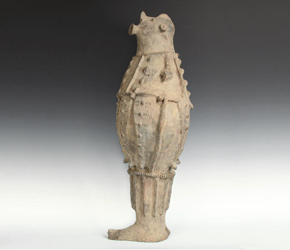 |
|
Our earliest ancestors lived much like wild beasts, scavenging and hunting when they were hungry. They also walked for miles in search of food and water and then left when either ran out. Revolutionary changes in human behavior came about when bright souls across the world realized settled life was possible through farming and domesticating animals. They also realized pottery vessels could be crafted and used to store water and preserve food. All over the world, the order of these evolutionary advances varied depending on region, but there is little doubt pottery making was an enterprise of almost every early human settlement. The development of pottery made it easier to stay and put down roots in a single place, and in turn, to make many more advancements.
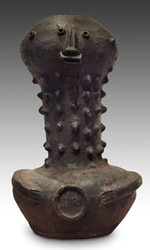 |
|
The beauty of ceramics from an archaeological point of view is they can withstand the test of time, unlike items made from other materials such as baskets or wooden sculptures that may disintegrate over extended periods. In Africa, excavations of ceramic wares have proved invaluable in piecing together the history of a continent that was largely passed down verbally prior to European contact. Though not always the case, changes in pottery styles often indicated social or political change and offered clues about migrations and the establishment of trade routes. As far back as 8,000 BCE to the present day, the creation and use of pottery has changed very little in Africa, where it is still a central aspect of everyday societal and religious life.
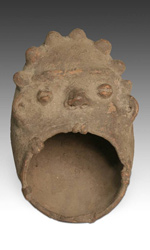 |
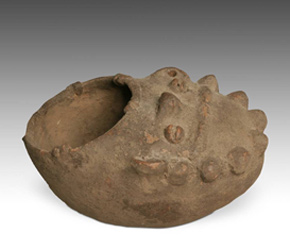 |
|
Ceramic works from Africa can be loosely divided into two categories: terra cotta figurative art and earthenware vessels. In opposition to figurative art, ceramic vessels can be broken down into two sub-categories: utilitarian and ceremonial wares. It is possible to find examples that appear to combine the two major categories when encountering figurative vessels; yet, upon examination figurative vessels were almost always used in ceremonial contexts.
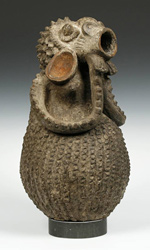 |
|
The association between pottery and ritual may not seem evident at first. To ancient people, the transformation of raw soft clay to hardened brittle pottery in a pit of fire must have appeared nothing short of magical. The collection of clay itself was also wrapped in ritual due to the close connection between humanity and nature. Even the firing process was considered sacred and often involved offerings to ensure its success. In many respects, the transformation from clay to fired ceramics was a form of alchemy, and in this regard was related to metal smithing. In many African societies, both potters and metal smiths were elevated in status because of their abilities to create magical objects imbued with all sorts of powers. It comes as no surprise that some of the earliest figurative pottery vessels were found in elaborate burial sites.
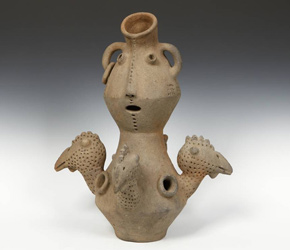 |
|
Sometimes, figurative vessels were hardly usable in a practical sense. For example, those crafted by the Mambila people in Cameroon are highly detailed, expressive vessels that could almost be passed off as figurative sculptures – except they are clearly containers made to be filled with substances such as water, food or medicine. In addition, they could also be filled with spiritual elements such as souls, life energy or healing powers. Regardless of what they illustrate, all figurative vessels are hollow and have the potential to be filled. The more impractical they are the more they earn the name “pseudo vessel.” Those made by the Mambila have two openings, one on the back and a protruding mouth, which may have allowed for substances inside to be dispensed. However, most do not appear as if they have been used this way, suggesting they have symbolic status. They have also been described as “soul vessels.” In this regard, they may be related to ancestor veneration.
Figurative vessels also hold a similar place of importance among several ethnic groups living in northeastern Nigeria. The Longuda, Cham and Mwana people share similar art and aesthetic styles. Vessels called kwandalowa by the Longuda and itinate by the Cham and Mwana were used for divination rituals and as protection from malevolent spirits. These highly valued vessels were also believed to absorb and contain illnesses. Consequently, they were highly regarded as powerful healing objects. As progress marches on and humanity evolves, the art of crafting these elaborate vessels is being lost by successive generations among these ethnic groups. Today, only a handful of elders know of their existence and purpose.
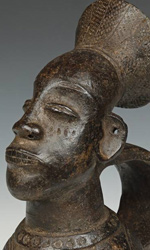 |
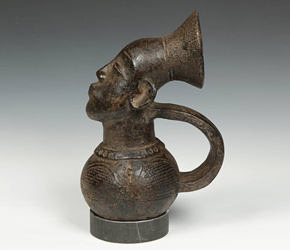 |
|
Alternatively, figurative vessels made by the Mangbetu people of the Democratic Republic of Congo are more frequently associated with storing and serving beverages during initiations and other important ceremonies. These vessels frequently depict females with elongated heads and intricate coiffures. They reflect a form of female prestige and the concept of ideal beauty among the Mangbetu. Elongated heads, transformed during infancy by binding, was a symbol of status among the ruling classes of the Mangbetu. Though the custom was abandoned by the middle of the 20th century, the style is still considered beautiful today and women often coil their hair to reflect the image of an elongated head. The vessels illustrating head elongation were commissioned by chiefs as a reflection of their authority and prestige, but once discovered by the West they became inspirational art pieces and gained worldwide recognition.
Anthropomorphic and figurative vessels occupy a unique place in African art. They display the balance between various realms – the utilitarian and ceremonial, secular and religious, and material and spiritual. The artistic ability and skill of the potters makes one want to call them sculptors; however, their creations are distinctly separated from figurative terra cotta sculpture by function and use. Half a world away from where they were created, African figurative ceramic vessels still display dignity, esteem and personality. Today, they are valued by collectors for their individuality, beauty, diversity, rarity and extraordinary design – qualities that fill these artworks to the brim.
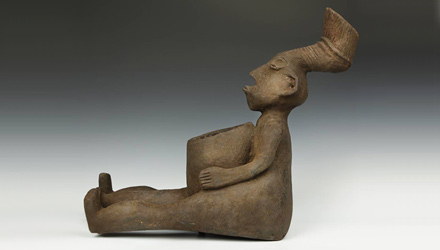 |